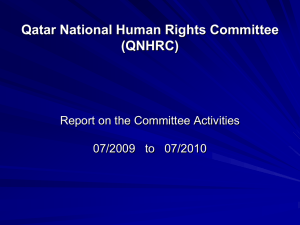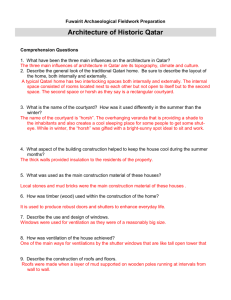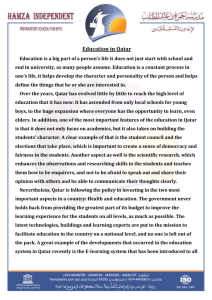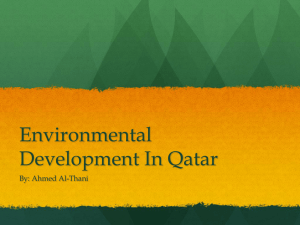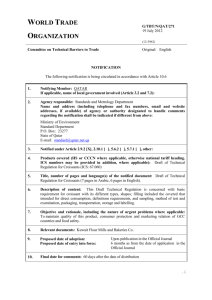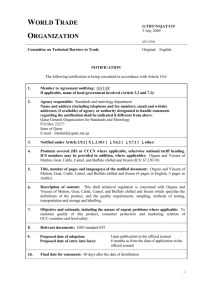The RAND Corporation is a nonprofit institution that research and analysis.
advertisement
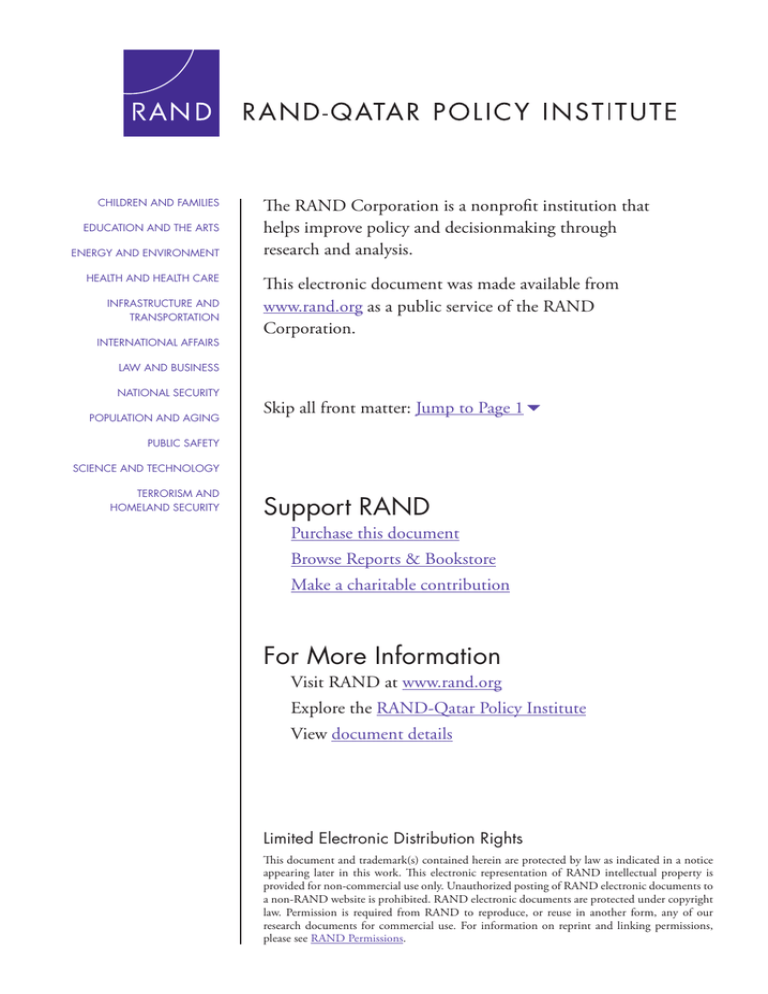
CHILDREN AND FAMILIES EDUCATION AND THE ARTS ENERGY AND ENVIRONMENT HEALTH AND HEALTH CARE INFRASTRUCTURE AND TRANSPORTATION INTERNATIONAL AFFAIRS The RAND Corporation is a nonprofit institution that helps improve policy and decisionmaking through research and analysis. This electronic document was made available from www.rand.org as a public service of the RAND Corporation. LAW AND BUSINESS NATIONAL SECURITY POPULATION AND AGING Skip all front matter: Jump to Page 16 PUBLIC SAFETY SCIENCE AND TECHNOLOGY TERRORISM AND HOMELAND SECURITY Support RAND Purchase this document Browse Reports & Bookstore Make a charitable contribution For More Information Visit RAND at www.rand.org Explore the RAND-Qatar Policy Institute View document details Limited Electronic Distribution Rights This document and trademark(s) contained herein are protected by law as indicated in a notice appearing later in this work. This electronic representation of RAND intellectual property is provided for non-commercial use only. Unauthorized posting of RAND electronic documents to a non-RAND website is prohibited. RAND electronic documents are protected under copyright law. Permission is required from RAND to reproduce, or reuse in another form, any of our research documents for commercial use. For information on reprint and linking permissions, please see RAND Permissions. This product is part of the RAND Corporation monograph series. RAND monographs present major research findings that address the challenges facing the public and private sectors. All RAND monographs undergo rigorous peer review to ensure high standards for research quality and objectivity. Qatar’s School Transportation System Supporting Safety, Efficiency, and Service Quality Keith Henry, Obaid Younossi, Maryah Al-Dafa, Shelly Culbertson, Michael G. Mattock, Thomas Light, Charlene Rohr With Sarah Al-Dorani, Hamad Al-Ibrahim, Mashail Al-Naimi, Louay Constant, Mohammed Makki, Georgette Mansour, Joy S. Moini, Parisa Roshan, Paul Sorensen, Flavia Tsang Prepared for the Qatar Amiri Diwan R AND- QATA R POLI C Y I NS TI TU TE The research described in this monograph was prepared for the Qatar Amiri Diwan and conducted within RAND Infrastructure, Safety, and Environment, a division of the RAND Corporation, and the RANDQatar Policy Institute, a collaboration between RAND and the Qatar Foundation. Library of Congress Cataloging-in-Publication Data Henry, Keith. Qatar's school transportation system : supporting safety, efficiency, and service quality / Keith Henry, Obaid Younossi, Maryah Al-Dafa, Shelly Culbertson, Michael G. Mattock, Thomas Light, Charlene Rohr. pages cm Includes bibliographical references. ISBN 978-0-8330-6024-2 (pbk. : alk. paper) 1. School children--Transportation­— Qatar. I. Title. LB2864.H46 2012 371.8'72095363—dc23 2012003379 The RAND Corporation is a nonprofit institution that helps improve policy and decisionmaking through research and analysis. R AND’s publications do not necessarily reflect the opinions of its research clients and sponsors. R® is a registered trademark. © Copyright 2012 RAND Corporation Permission is given to duplicate this document for personal use only, as long as it is unaltered and complete. Copies may not be duplicated for commercial purposes. Unauthorized posting of RAND documents to a non-RAND website is prohibited. RAND documents are protected under copyright law. For information on reprint and linking permissions, please visit the R AND permissions page (http://www.rand.org/ publications/permissions.html). Published 2012 by the RAND Corporation 1776 Main Street, P.O. Box 2138, Santa Monica, CA 90407-2138 1200 South Hayes Street, Arlington, VA 22202-5050 4570 Fifth Avenue, Suite 600, Pittsburgh, PA 15213-2665 RAND URL: http://www.rand.org/ To order RAND documents or to obtain additional information, contact Distribution Services: Telephone: (310) 451-7002; Fax: (310) 451-6915; Email: order@rand.org Summary In recent years, Qatar has experienced dramatic development and population growth. Traffic has increased substantially, and student enrollments continue to grow. The State of Qatar has embarked on many educational reform efforts, the most significant of which is the implementation of Independent Schools in 2005 (Brewer et al., 2006). Among many educational reforms, one option being considered under the Independent School model is wider school choice, allowing parents to choose schools for their children regardless of where they live. This expansion of school choice is likely to increase the need for school transportation and adds complexity to school transportation operations. In consideration of the many challenges associated with Qatar’s continued growth and demographic changes, Qatar is interested in updating its school transportation system. Stakeholders, including school administrators and the Supreme Education Council, have expressed a variety of concerns about the current state of school transportation, ranging from safety and traffic congestion to efficiency and quality of the service. Purpose The purpose of this study is to (1) assess stakeholder perspectives on school transportation, (2) help identify a vision and goals for the school transportation system, (3) identify international norms for school transportation, (4) compare Qatar’s current school transportation system with international norms, and (5) highlight strategies for Qatar to achieve the proposed vision and better align its school transportation system with international norms.2 For the purposes of this study, we confine our definition of international to those practices employed by the United States, Canada, Western 2 In addition to the above tasks, the project also included the development of an implementation plan as a sixth task. Building on the recommendations in this document, RQPI will provide to the government of Qatar a separate, companion document, titled “Qatar’s School Transportation System: Implementation Manual,” that highlights challenges, timelines, and organizational responsibilities associated with the recommended strategies. xiii xiv Qatar’s School Transportation System: Supporting Safety, Efficiency, and Service Quality Europe, and Gulf Cooperation Council (GCC) countries with recently modernized school transportation systems. We regard as norms those practices that are repeatedly referenced in the literature we reviewed and appear in case studies explored under this project. Vision and Goals An important part of this study was developing a vision and goals for the school transportation system. To develop the vision, we reviewed key planning documents3 for Qatar and interviewed key stakeholders to glean from them what characteristics they thought the school transportation system should embody. From those interviews and documents, we distilled a four-element vision. The elements are as follows: • • • • Provide safe, efficient, and high-quality transportation for Qatar’s students. Support educational options by enabling mobility and access. Provide a transportation experience that is supportive of Qatari values and culture. Minimize the impact on traffic congestion and the environment. Once we had developed the elements of the vision, we next determined the goals that would be necessary to realize them. For example, to achieve the safety portion of the first vision element, we identified as a goal “Effective safety standards and measures are established and enforced.” To achieve the vision element of minimizing the effect on traffic congestion, we identified as a goal “Transportation operations minimize delays and traffic around schools.” Having defined visions and goals, we then worked to identify strategies that would support them. Strategies to Support Vision and Goals We identified a number of strategies that would bring Qatar’s school transportation system into closer alignment with international norms. We also identified a few strategies that, while not commonly practiced, may be of interest to Qatar due to the stated preferences of administrators and parents. The strategies can be grouped into five major categories: • • • • • school zone management bus design and operation fleet operations and management information, communication, and analysis student management. 3 These included the Qatar National Vision 2030 (Qatar General Secretariat for Development Planning, 2008), the Qatar National Master Plan, and the Transportation Master Plan. Summary xv Each category contained several strategies, and these are listed in Table S.1. Of the strategies listed in Table S.1, 13 stood out in terms of being cost-effective and carrying little implementation risk. We list these in our recommendations at the end of this summary. Evaluation of Select Strategies In identifying possible strategies for Qatar’s school transportation system, some options emerged that may offer significant benefits but raise important questions related to culTable S.1 Candidate Strategies for Qatar’s School Transportation System and the Vision Elements They Support Strategy Supported Vision Elements School zone management School zones Safety, Traffic Traffic laws/education/enforcement Safety, Traffic Bus design and operation School bus standards Safety, Quality Bus driver standards/training/eval. Safety, Quality, Values Standard checklists and reporting Safety, Quality, Efficiency Technology tools (e.g., RFID) Maintenance standards/monitoring Safety, Efficiency Safety, Quality Fleet operations and management Bus route optimization Efficiency Pick-up/drop-off points Efficiency Staggered school start times Fleet size and composition Efficiency, Traffic Quality Information, communication, and analysis Policy manual Awareness campaign Stakeholder feedback process Gather/assess safety data Establish/monitor efficiency metrics Safety, Quality, Efficiency Safety, Access Safety, Quality, Efficiency, Values Safety Efficiency, Quality Student management Bus monitor enhancements Student loading and unloading procedures Student behavior management Media on buses Values, Quality Safety Values, Quality Quality xvi Qatar’s School Transportation System: Supporting Safety, Efficiency, and Service Quality tural concerns, uncertain cost-effectiveness, or inconsistency with international norms. Due to uncertainties about their costs and benefits, we provided a preliminary evaluation as a starting point for their consideration. Strategies that may warrant further consideration include the following: • transitioning to smaller buses, to shorten route lengths and reduce student time spent on the bus • decreasing the number of buses servicing schools, which would increase the number of students on each bus and reduce costs • implementing bus stops to improve the efficiency of the school bus system • staggering school start times, to reduce congestion and potentially enable buses to service multiple morning and afternoon bus routes • integrating Radio Frequency Identification (RFID) tag devices into buses to enhance safety • providing students access to media on buses, to enhance learning and increase bus ridership • changing the requirements for bus monitors to enhance safety. Figure S.1 summarizes the results of our preliminary evaluation of these strategies. If a strategy is assigned a green value for a particular criterion, this indicates that it enhances performance in that dimension. A red designation indicates that the strategy degrades performance in that dimension. In some cases, the effect of a strategy may be uncertain or produce mixed (both positive and negative) effects. We indicate this with a yellow value. In addition, we have added + and – symbols to indicate areas where strategies may have a particularly significant positive or negative effect. Concluding Observations and Recommendations This monograph provides many options to implement in Qatar’s school transportation system; these recommendations are summarized below. While all of these strategies are potentially viable, Qatar must decide which goals to prioritize for near-term implementation.4 Regardless of which strategies are implemented, decisionmakers should keep in mind that Qatar’s school transportation system is indeed a system. As is the case with any system, its parts work together, not in isolation. So any change made in one part of the system must be weighed with effects on other parts of the system. Some of the recommendations listed below are complementary and reinforcing. Such recommenda4 RQPI will provide to the government of Qatar a separate, companion document, titled “Qatar’s School Transportation System: Implementation Manual,” that will assist with these decisions and provide guidance on implementing each of the strategies. Summary xvii Figure S.1 Expected Performance of Selected Other Strategies Safety Service Cost Impact on Traffic/ Environment Acceptance Bus Demand Implementation Obstacles Transition to smaller buses N/A N/A N/A Reduce number of buses N/A N/A N/A Institute school bus stops Stagger school start times N/A Integrate RFID tags into buses Provide access to media on buses N/A N/A N/A N/A N/A N/A N/A N/A N/A N/A Enhance bus monitor requirements Enhanced performance N/A Uncertain or mixed performance N/A N/A Degraded performance NOTE: N/A = Not applicable. RAND MG1136-S.1 tions are best pursued as a set of coordinated initiatives. Other recommendations may be implemented as stand-alone initiatives. In choosing which strategies to implement, it will be important to consider which sets of initiatives will achieve the most efficient implementation and which sets of initiatives will achieve the greatest synergies after implementation. This consideration should include weighing the cost of implementing the system against the benefits that would accrue. Furthermore, Qatar’s school system does not operate in isolation from other aspects of Qatari society, and thus changes made must mesh with Qatar’s other concerns and priorities. Implementation of the strategies mentioned here will require extensive coordination among the entities involved with school transportation in Qatar, including the Amiri Diwan, the Office of the Heir Apparent, the Supreme Education Council, school bus operators, schools in Qatar, the Urban Planning and Development Authority, the Public Works Authority, and the Traffic Police. Execution will certainly be a team effort requiring the active participation of all these stakeholders. xviii Qatar’s School Transportation System: Supporting Safety, Efficiency, and Service Quality Recommended Strategies We recommend that Qatar adopt the proposed vision and goals for the school transportation system. In the course of our study, we have identified a number of areas where Qatar’s school transportation system does not conform to international norms. Should Qatar choose to conform to international norms, many of the strategies presented in Table S.1 may be viable in terms of implementation and cost. To bring the school transportation system in line with common international practices, Qatar should focus on the following 13 strategies: • Establish clearly marked school zones with standardized safety features and traffic management around schools. • Use traffic laws, education, and enforcement to control the behavior of private drivers near schools and school buses. • Adopt international standards for school buses. • Establish universal standards for licensing and training bus drivers. • Make drivers responsible for completing daily, standardized checklists and reports to ensure adherence to standardized processes. • Establish maintenance standards and a process for monitoring compliance. • Publish a system-wide policy manual. • Conduct awareness campaigns to reinforce practices, policies, and laws. • Provide school administrators and parents a mechanism for giving transportation officials feedback about issues with school transportation. • Maintain and track safety data to properly evaluate safety and formulate targeted responses to safety problems. • Establish performance metrics and develop a system to gather data to measure system-wide performance. • Ensure that trained school staff are available to supervise bus loading and unloading during peak hours. • Enforce greater discipline on buses.
